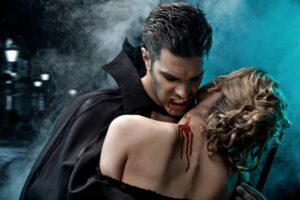
As writers, we know that a story without conflict (whether man vs supernatural or not) is like a comedy without the jokes. Boring. Conflict is one story element that keeps readers engaged and flipping pages.
But…
I remember when I was a new writer. I’d hear about how important conflict was all the time, which was great. But no-one told me what including conflict actually meant. And, as a fantasy writer, I needed to include a specific kind of conflict in my novels.
This type of conflict goes by a few names, but I’ll bet you’ve heard of it:
- Character vs supernatural conflict
- Person vs supernatural conflict
- Woman vs supernatural conflict
- Man vs supernatural conflict
I found it hard to know what conflicts to include and whether they’d satisfy readers… until I discovered the Fictionary Story Editing Software, and the magic of the Fictionary Story Arc. With the Fictionary Story Editing Software, I can see my story using a series of visual insights, which make editing so much easier.

More on that later.
But first…
Grab your witch’s hat, your fae wings, and your plastic vampire teeth my writerly friend, because we’re about to explore character vs supernatural conflict.
What is Character vs Supernatural Conflict?
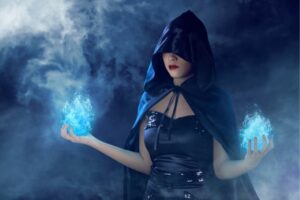
Whatever you choose to call it, the premise is the same.
In man vs supernatural conflict stories, your protagonist and/or point of view characters are in direct opposition with an otherworldly foe. This otherworldly foe uses powers of forces that are mystical or magical in nature.
The antagonist might have supernatural abilities the protagonist doesn’t (i.e., the antagonist is a druid, and the protagonist is human), or both the protagonist and antagonist might have ethereal powers. The important thing is these supernatural powers must play a key part in your story’s central conflict.
And, don’t forget, man vs supernatural conflict isn’t all about magic. Your protagonist could fight ghosts, ghouls, werewolves, or vampires. The point is, their adversary is not part of our everyday world.
Some people also say many subgenres of science-fiction (where the tech is so advanced it’s almost magical) falls into this conflict category.
With this in mind, the most likely genres where you’ll find man vs supernatural conflict include (but aren’t limited to):
- Fantasy
- Paranormal
- Horror
- Magical Realism
NOTE: While the term man vs supernatural is commonly used, “man”, in this context refers to humankind. More inclusive terms, like “person vs supernatural” are preferable, and we’ll use the different terms interchangeably in this article.
Where does Character vs Supernatural Conflict Fit on the Internal Vs External Conflict Scale?

Many people ask whether person vs supernatural conflict is internal conflict or external conflict.
It’s a really good question.
Here’s a quick rundown.
Internal Conflict
Internal conflict is a struggle the character has with themselves. Most characters have a flaw they’re trying to overcome. Every time they try to fight against this flaw, it creates powerful emotions inside of them, and they have to battle these emotions.
External Conflict
External conflict is a struggle the character faces with something (or someone) outside themselves. This is directly related to the protagonist’s story goal. Say you’re writing a thriller, and your protagonist’s ultimate goal is to catch the killer. There should be a ton of conflict between your protagonist and the murderer.
Types of external conflict include:
- Character vs character: like Lucy vs Josh in Sally Thorne’s contemporary romance, The Hating Game
- Person vs society: Like Tris Prior vs The Faction System in Veronica Roth’s Divergent
- Character vs nature: Like Mark Watney vs Mars in The Martian
- Person vs technology: Like Jane and Emma vs “Housekeeper” in J. P. Delaney’s The Girl Before
Remember, man vs supernatural conflict occurs when your protagonist is fighting a foe with magical or mystical abilities. They’re fighting something outside themselves, which makes this an external type of conflict.
5 Examples of Character Vs Supernatural Conflict
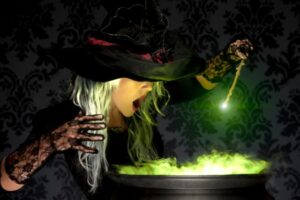
1. Character Vs Character
If you’re looking for a great example of character vs character supernatural conflict, look no further than V.E. Schwabs 2013 novel, Vicious.
Former college roommates, Victor Vale and Eli Cardale, discover the secret behind developing superpowers (becoming ExtraOrdinaries, or EOs). In the course of developing these powers their other friend (Angie) dies.
Eli turns himself in to the police and rats Victor out as well.
When Victor gets out of jail ten years later, he’s hellbent on using his powers to get revenge on Eli, which is why this is a character vs character conflict story.
2. Character Vs Society
Supernatural stories can also include character vs society conflict.
Let’s look at Trudi Canavan’s 2001 young adult high fantasy novel, The Magician’s Guild, as an example.
Our protagonist, Sonea, lives in a world where only highborns are magicians. A “Dwell” like Sonea, who lives in the slums of Imardin, shouldn’t have magic. And yet, she develops it. Eventually, she attends The Magician’s Guild to learn to wield her magic, but faces scorn, bullying, and other unspeakable things from her fellow students.
Her story is one of societal prejudice and battling to come to terms with who she is.
This falls into the character vs society bracket, not character vs organisation, because the majority of Imardin believe slum dwellers are “less than” and shouldn’t possess magic.
3. Character Vs Nature
A great example of a character vs nature conflict story driven by the supernatural is Jeff VanderMeer’s science-fiction novel, Annihilation, released in 2014.
The protagonist, known only as the Biologist, is part of a team sent to investigate the otherworldly “Area X”, which has been cut off from civilization for some time. As the story progresses, the biologist realizes the landscape is filled with plantlife and creatures that exude an air of the supernatural.
So, the team is up against natural elements and supernatural phenomenon, which is why Annihilation belongs in this category.
4. Character Vs Creature
In the 2015 fantasy folklore novel, Uprooted, by Naomi Novik, protagonist Agnieszka is in conflict with the Corrupted Wood.
The Corrupted Wood, only a short distance from Agnieszka’s village, contains dark power that spawn twisted supernatural creatures. These creatures terrorize the surrounding villages and make life for the inhabitants hell.
Eventually, Agnieszka purifies the wood and brings peace to her village, but not before she does battle with a host of creatures from the Corrupted Wood.
5. Character Vs Organisation
Character vs Organisation conflict is similar to Character vs Society, but this occurs when the protagonist is facing opposition from a particular group of people within society, not society as a whole.
A great example of a story that sets up character vs organisation conflict well is Deborah Harkness’s 2011 paranormal romance novel, A Discovery of Witches.
In Harkness’s All Souls Trilogy, inter-species relationships between creatures (witches, vampires, and daemons) are forbidden by the Congregation (the organisation that sets the rules for the supernatural world.
So, when witch Diana Bishop and vampire Mathew Clairmont fall in love, The Congregation aren’t happy about it. The reason this story falls into character vs organisation and not character vs society is because many creatures believe the Congregation’s laws are outdated and need to change.
How Can the Fictionary Story Arc Can Help You Increase Man vs Supernatural Conflict?
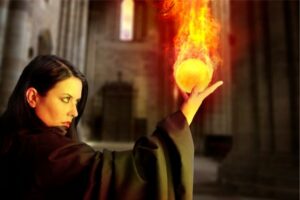
I promised we’d get to the Fictionary Story Arc, and here we are.
For those of you who’ve never used the Fictionary Software, or seen the Fictionary Story Arc, you’re in for a real authorial treat.
The Fictionary Story Arc is a Visual Insight in the Fictionary Software that shows you the five story arc scenes in your manuscript.
The blue line represents the recommended story arc, which is the story arc that almost every mega-bestseller follows. The yellow line shows you how close your story arc scenes are to the recommended story arc.
But that’s not all.
The story arc also shows how well paced your novel is. Where you see a flattening of the yellow line on the graph above, this shows the story drags because there’s too much space between one story arc scene and the next. It’s in these flat stretches readers ask themselves, “Why is nothing big happening? Maybe I’ll see what’s on Netflix.”
Where you see lines curving sharply upward on the graph above, this shows the story feels too rushed because there’s not enough space between one story arc scene and the next. It’s in these rushed moments readers will say, “Huh. Everything’s happening too fast, and I don’t really know who these characters are. Maybe I’ll see what’s on Netflix.”
But How Does This Help Me Include More Person vs Supernatural Conflict?
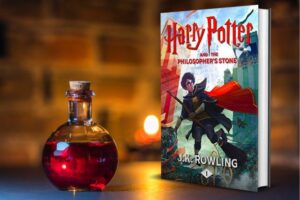
That, my writing chum, is a fantastic question.
Next time you’re reading your favorite man vs supernatural conflict novel, pay attention to what happens in each of the story arc scenes. You’ll often find the story arc scenes are where the most supernatural conflict and/or circumstances occurs.
Let’s look at J. K. Rowling’s 1997 fantasy novel, Harry Potter and the Sorcerer’s Stone, as an example.
Inciting Incident: Harry’s Hogwarts Letter
In this scene, the reader is introduced to heaps of magic, such as:
- Hagrid arriving at the hut on a flying motorbike
- Hagrid blasting the door down using magic
- Hagrid conjuring a pig’s tail on Dudley’s backside
- Hagrid using a spell to light the fire
Plot Point 1: Arrival at Hogwarts
- Harry meets the house ghosts
- Harry sees moving staircases
- Harry sees talking portraits
- Harry enters the magical great hall at Hogwarts
Middle: Injured Playing Quidditch
- Harry’s flying his magical broomstick
- Someone hexes Harry’s broom
- We’re led to believe it’s Professor Snape, who’s chanting from his spot in the spectator’s stands
- Hermione casts a fire spell to distract Snape from the hexing the broomstick
Plot Point 2: The Forbidden Forrest
- Harry sees a unicorn
- Harry meets a centaur
- He’s attacked by a magical figure in disguise, and would’ve died if not for the centaur’s intervention
Climax: Harry Fights Voldemort
- Harry uses broomstick to catch a magical key
- Hermione uses fire magic to defeat the devil’s snare
- The magical chess match
- The final supernatural battle with Voldemort
See how the most magic (aka person vs supernatural conflict) occurs during the key story arc scenes? When reviewing you story arc scenes, aim for something similar.
Conclusion: Man Vs Supernatural Conflict

You’ve navigated the intricacies of man vs supernatural conflict, and now you’re standing at the edge of a magical abyss, asking, “How do I make this all come together?”
Look no further than the Fictionary Story Editing Software.
Fictionary doesn’t just tell you where your story needs work. It shows you. With its revolutionary Story Arc feature, you can visualize exactly where to ramp up your supernatural elements, ensuring they’re not just ornaments but integral to your plot.
The software makes it crystal clear where your story either drags or rushes, providing you with the perfect pacing that every man vs supernatural tale requires. If you’re serious about mastering this fantastical form of conflict, Fictionary is your must-have writing and story editing companion.


